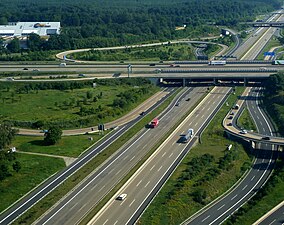User:Martinvl/sandbox
- Even in high-income countries, some regional roads may be of lesser quality: road 945 in Kemijärvi; gravel and 15% slope
- Latvian regional road P86 in 2020, uneven and over-patched
- Country road in winter, Norway
- Autobahn interchange near Frankfurt, Germany
- Narrow residential street, Bilbao
Temporary heading
editInternational Vehicle Registraion Codes
editAll European countries demand that foreign vehicles display their country of origin. This can either be inside an oval disk or in small leters on the left-hand side of their number-plate. The codes used do not follow the ISO 3166 system or the convention used for internet domains but follow codes allocated at the 1909 or 1924 international conventions.
All the European country codes are listed alongside, together with the flag of the country concerned and the name of the country in the local language(s) and script. If you are planning to drive in a country that does not use the Latin script, it is advisable to familiarise oneself with the local script. Where two or more languages are in widespread use in a country, the local name is given in all commonly-used languages
- International identifier codes for Germany
- A 140 mm by 110 mm sticker which is attached to the vehicle's bodywork.
- International code is on the blue strip on this registration plate.
By country
editFor country-specific info, you should generally consult the By car sections of the country's article. However, Wikivoyage does have dedicated articles about driving in some European countries:
Denmark
edit- See also: Driving in Denmark
While the bicycle can be a good alternative to the car in Denmark, driving is usually easy. Parking in cities can be a hassle, though.
Finland
edit- See also: Driving in Finland
With exception of the coastal areas, Finland is sparsely populated. Some roads are very scenic.
France
edit- Main article: Driving in France
Similar to much of Europe, driving in France is very straightforward unless you go through the cities.
Germany
edit- Main article: Driving in Germany
Germany is known for its motorways, called Autobahns.
Iceland
edit- Main article: Driving in Iceland
Iceland is a fairly large island with a sparse population and no railways, so driving is the obvious choice for getting around outside the capital region. The ferry from Denmark takes three days, so consider hiring a car rather than bringing your own.
Italy
edit- Main article: Driving in Italy
It shouldn't be hard to get around Italy if you have the money to pay tolls, and therefore drive on quieter roads.
Norway
edit- Main article: Driving in Norway
Norway goes a long way north to south, and by driving you can reach places in Norway that are difficult to reach using other forms of transport. Countless scenic drives on roads that are often narrow and steep. Distances and driving times are frequently underestimated. Driving in winter can be very challenging even for locals.
Poland
edit- See also: Driving in Poland
Poland has a decent system of public transport, though if you find it inconvenient you always can hit the road. Beware that roads are often congested, not up to western European standards and highways frequently go through small villages.
Portugal
edit- Main article: Driving in Portugal
From fast modern motorways to middling national roads to narrow unpaved rural roads, Portugal's roads offer varied landscapes and conditions. Sometimes rewarding and often challenging, driving in Portugal offers adventure beyond the country's rail and bus systems.
Russia
edit- Main article: Driving in Russia
The largest country in the world is so large that it is hard to get around, even by car. While viewing the countryside by driving is an interesting idea, it's best to know where you're going so you don't end up on the Kolyma Highway.
Spain
edit- Main article: Driving in Spain
Getting around for example central Madrid by car is usually a bad idea, but if you plan on exploring La Alpujarra it can be really convenient. Also, Spain has a good road network and is one of the largest countries in Europe.
Sweden
edit- Main article: Driving in Sweden
Generally, driving in Sweden works well, but be careful about driving in winter or going into wilderness areas and be careful about drinking before you drive.
Switzerland
edit- Main article: Driving in Switzerland
Switzerland is a small but mountainous country, so you will generally not need to drive long distances to get from place to place but the drive itself may be challenging.
United Kingdom
edit- Main article: Driving in the United Kingdom
European Data
edit§1: Where three numbers are listed, they refer to Ambulace, Fire and Police respectively. For the sake of brevity, alternate numbers such as 999 in the United Kingdom are not shown.
§2: Standard timezone / Daylight saving timezone
Driving
Except for Iceland where one drives on the right, the island nations of Europe (United Kingdom, Ireland, Malta and Cyprus) drive on the left. All other European countries drive on the right.
Electricty
Apart from Azerbijan, Belarus, Georgia and Russia who use 220 V at 50 Hz, all of Europe uses 230 V at 50 Hz.






